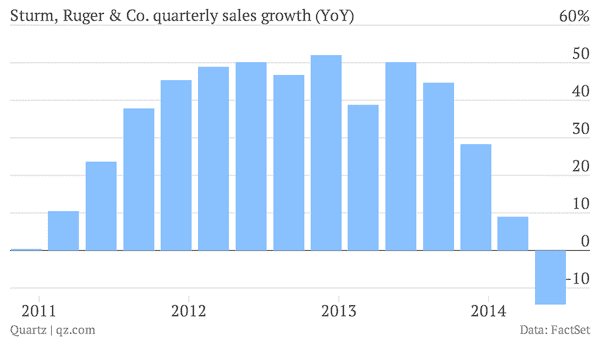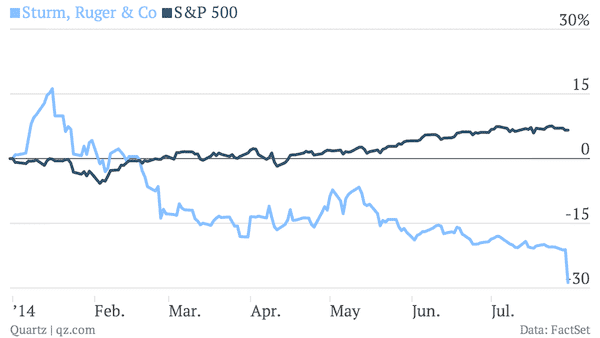Sturm, Ruger & Co, the nation’s largest publicly traded firearms manufacturer, announced on Wednesday a 14 percent decline in sales for the second quarter of 2014, indicating that demand for firearms has waned.
Earnings per share for the Southport, Connecticut-based company have also dropped 31 percent to $1.12 compared to projections of $1.23 between April-June, Bloomberg News reported.
To help explain the down numbers, Sturm, Ruger & Co’s CEO Michael Fifer spoke about how the political landscape has changed over the past several months, particularly the threat of legislation banning magazines holding more than 10 rounds of ammunition has been minimized.
“Our accessories business is much, much smaller than our firearms business, and last year, however, it spiked because [the politicians] were all trying to grab a headline and they were going [to] limit magazine sales, for example,” Fifer explained to Quarz.com.
“And so what did the consumers do: they went out of their way to buy every magazine they could get their hands on, for fear that it would be outlawed, and they wanted to get them so they could be grandfathered,” he continued.

With fewer gun-control bills on the horizon, fear-buying and hoarding is not as prevalent as it was in the aftermath of the mass shooting at Sandy Hook Elementary School in Newtown, Connecticut, which would understandably translate to a reduction in sales.
Another bellwether for the gun market is the number of background checks the FBI processes with its NICS system, (National Instant Criminal Background Check System). According to Ruger, NICS checks were down 12 percent in quarter two and 18 percent for the first half of the year. While there are limitations to using NICS checks as a prognosticator for gun sales, not all guns are purchased via a FFL nor are all background checks processed strictly related to gun purchases, the numbers paint a pretty clear picture: sales are down.
To get a better sense of the state of the gun industry, GunsAmerica reached out to the National Shooting Sports Foundation, the trade association for firearms and ammunition manufacturers.
“Demand is coming off of the peak of 2013, but the valley floor is higher than it was in 2012,” said Lawrence G. Keane, the NSSF’s Senior Vice President, Assistant Secretary & General Counsel.
“There are more guns and gun owners America ever before in the history of our nation,” he added.

While Keane’s observation’s are indeed true, one has to wonder what this all means for the average gun owner. Basically, me and you. From my vantage point, I think it’s turning into a buyer’s market, meaning supply is increasing (especially after all the reinvesting and expanding gun companies have done following the Obama gun boom in 2008 and then again in 2012), demand is leveling off, which should translate into lower prices or, at the very least, we should have an easier time picking up the firearms that are at the top of our wish list.
Of course, nothing is set in stone. And all it takes is another tragedy to rattle the cages of the lawmakers in Congress. But it appears that at least for now gun buyers are gaining real leverage in the marketplace.
